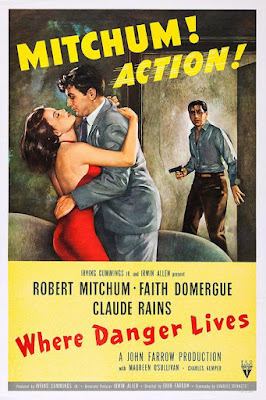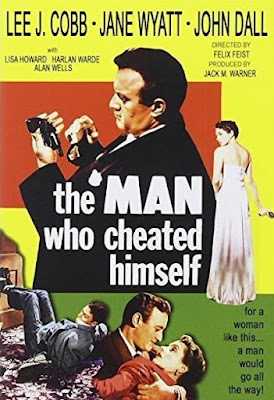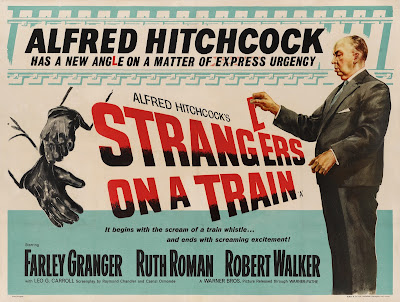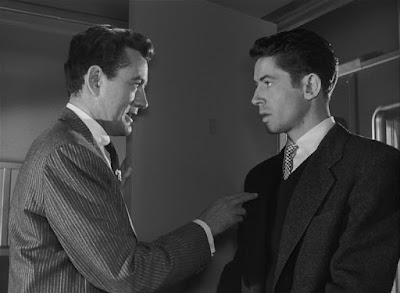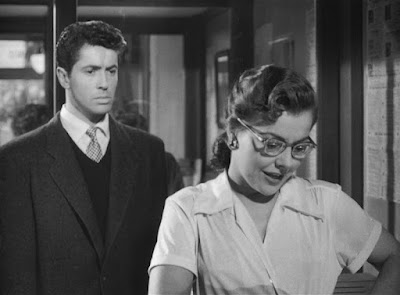Where Danger Lives (1950) Dr. Jeff Cameron (Robert Mitchum) is about to finish his stint at a hospital to go into private practice. His life takes a detour for the worse when he crosses paths with young, attractive suicide patient, Margo (Faith Domergue). They seem to hit it off until he learns about her older husband (played by Claude Rains in a small but substantial role). An argument and ensuing scuffle result in the accidental death of Margo’s husband. Now they’re on the run from the law, in a last-ditch attempt to reach the Mexican border. As Cameron slides deeper and deeper into trouble, he begins to question if Margo was lying about more than just her spouse. Where Danger Lives features solid performances all around. The normally sleepy-eyed Mitchum is used to best effect here, playing a man with a concussion who’s forced to stay awake.
Rating: ****. Available on DVD (Warner Archive double
feature disc with Tension)
A Colt is my Passport (1967) This Japanese neo-noir balances ample doses of crime drama with a spaghetti western sensibility. Jô Shishido stars as Shûji Kamimura, who’s hired by a local kingpin to assassinate a rival gang leader. He carries out the hit successfully, but now the leader’s son, teaming up with former enemies, is determined to rub out Kamimura and his guitar-strumming partner, Shun (Jerry Fujio). Shishido is riveting as Kamimura, a hitman with a staunch code of honor amidst a world without honor or integrity. The bullet-paced action sequences are punctuated by Harumi Ibe’s spirited western-tinged score (with shades of Ennio Morricone).
Rating: ****. Available on DVD (part of Criterion’s Nikkatsu
Noir set)
Leave Her to Heaven (1945) While the lush Technicolor cinematography doesn’t quite fit the noir aesthetic, Leave Her to Heaven’s sordid story (based on a novel by Ben Ames Williams) certainly qualifies. Novelist Richard Harland (Cornel Wilde) marries attractive Ellen (Gene Tierney), and soon discovers that things are not quite right with his wife. She wants him all to herself, and anyone who dares to get between them risks his or her own peril. Tierney is terrific as the manipulative, sociopathic Ellen, who will stop at nothing to keep her hold on Richard. The film also features a young Vincent Price (who also appeared with Tierney in Laura and Dragonwyck) as Ellen’s jilted former fiancé Russell Quinton. Price shines in a great scene cross-examining Richard and Ellen’s sister Ruth (Jeanne Crain) in the courtroom.
Rating: ****.
Available on Blu-ray and DVD
Tension (1949) Richard Basehart stars as Warren Quimby, a mild-mannered pharmacist married to shrewish Claire (Audrey Totter). Claire wants more than what his modest salary can provide (in an early scene, she turns her nose up at his offering of a house in the suburbs), promptly leaving him for wealthy businessman, Barney Deager (Lloyd Gough). Quimby creates a second identity so he can carry out his revenge against Deager. His plans are thrown off, however, when he encounters something he hadn’t counted on, a new love interest (Cyd Charisse). Barry Sullivan is good as a police detective investigating Deager’s murder, but the film’s best performance is by Totter, as the self-obsessed, thoroughly despicable Claire.
Rating: ****. Available on DVD (Warner Archive double
feature disc with Where Danger Lives)
Sudden Fear (1952) Joan Crawford stars as noted playwright Myra Hudson, who falls in love with, and subsequently marries, Lester Blaine (Jack Palance), an actor whom she fired from a stage production. We soon discover that Blaine’s devotion is little more than a ruse, as he plots Myra’s demise with his scheming girlfriend Irene (Gloria Grahame). Crawford is good in her role as a woman scorned, although it’s a little tough to accept Myra and Lester as a credible couple. Although this might be a step below some noirs on this list, the performances are solid, and there are some tense moments during the film’s climax, when Myra flees for her life.
Rating: ***½. Available on Blu-ray, DVD and Kanopy
The Man Who Cheated Himself (1950) Lee J. Cobb stars as San Francisco police detective Ed Cullen. When his new flame, Lois Frazer (Jane Wyatt), shoots her estranged husband, he helps her cover up the crime. Unfortunately for Ed, eager rookie detective Andy (John Dall), his younger brother, seems to be connecting the dots. It soon becomes a game of deflection and obfuscation, as Ed attempts to throw him off the trail. Director Felix E. Feist makes good use of the film’s San Francisco setting, particularly the Golden Gate Bridge and Fort Point. Dall is a bit stiff, but Cobb is excellent as a formerly good detective turned bad, consumed by his guilty conscience.
Rating: ***½. Available on Blu-ray, DVD, Amazon Prime and Kanopy

